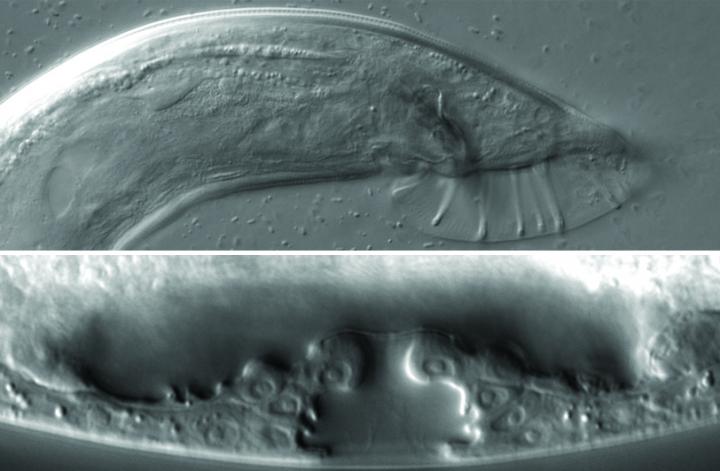
Credit: Helge Grosshans, FMI
The let-7 gene is considered a fundamental regulator of developmental timing in animals – in organisms as distinct as worms and mammals. It produces a small RNA, known as the let-7 microRNA (miRNA), which can silence other genes. In the model organism C. elegans, let-7 controls the transition from a juvenile to an adult animal. This transition, like human puberty, involves the formation of mature sexual organs, in this case the vulval-uterine tract for the hermaphrodite and the tail in the male. (There are no female C. elegans worms – only hermaphrodites that can either self-fertilize or mate with the less abundant males.) The vital importance of let-7 is highlighted by the fact that worms with a dysfunctional let-7 die a dramatic death: they rupture through the vulva! (see video*)
In a study published in Life Science Alliance today, the group of Helge Großhans now presents new findings about how let-7 controls worm puberty. Using precision genome engineering, the researchers specifically interfered with regulation of one or all targets of let-7. They found that the only relevant target of let-7 for the formation of sexual organs is an mRNA called lin-41. This mRNA encodes an RNA binding protein that silences four other mRNAs. So basically, let-7 inhibits lin-41, which therefore cannot inhibit the expression of the four genes anymore; those get expressed and promote the transition of the worm to adulthood.
“Although extensive studies of the C. elegans developmental timing pathway have helped to identify many of its players, we still don’t understand well how these players function together. With this study, we are beginning to fill the gaps and to elucidate the molecular mechanisms underlying the transition from juvenile to adult – an important transition in the life of worms, and humans,” says Großhans. “Intriguingly, timing defects in human puberty have been linked to genetic variations that alter let-7 activity. It will therefore be interesting to study whether mammalian LIN41 also controls sexual organ maturation in mammals and possibly other puberty-related events.”
Großhans also notes that the study provides unexpected insight into another field, that of miRNA function. “miRNAs are often thought to act through a network activity where they silence many targets modestly but coordinately. However, our work clearly demonstrates that the let-7 miRNA functions through only one target, lin-41. Although experiments comparable to what we have done here are lacking for other miRNAs, there are other instances that seem to fit b
###
etter to a model of only one or a few key miRNA targets. Hence one might question whether the network activity model really describes the predominant mode of miRNA function in animals.”
* Reference video: Ecsedi M, Rausch M, Großhans H. Dev Cell. (2015) 32:335-44)
Original publication
Florian Aeschimann, Anca Neagu, Magdalene Rausch, and Helge Großhans. let-7 coordinates the transition to adulthood through a single primary and four secondary targets. Life Science Alliance, April 2019 | Volume 2, No. 2 (published online March 25, 2019)
Contact
Helge Großhans, [email protected]
Helge Großhans is a senior group leader at the FMI. With his research group, he investigates questions of developmental timing, especially as they relate to the function, regulation and metabolism of RNAs. For their investigations, the scientists use the nematode C. elegans and cultured mammalian cells models. Their research is funded by the Swiss National Science Foundation and the European Research Council.
About the FMI
The Friedrich Miescher Institute for Biomedical Research (FMI), based in Basel, Switzerland, is a world-class biomedical research institute dedicated to understanding the molecular mechanisms of health and disease. Its main areas of expertise are neurobiology, quantitative biology and epigenetics. With a staff of about 350, the FMI offers an exceptional training environment for PhD students and postdoctoral fellows from around the world. The FMI is affiliated with the University of Basel and the Novartis Institutes for BioMedical Research, and is currently being co-led by Silvia Arber and Dirk Schübeler.
Media Contact
Isabelle Baumann
[email protected]
Original Source
https:/
Related Journal Article
http://dx.




